Experienced Investor
Tech Bubble 2.0: Fact or fiction?

When the Nasdaq dropped 3.1% overnight, whispers intensified that a second tech bubble was set to burst. But should private investors be spooked?
Eye-wateringly expensive acquisitions and a recent wave of billion-dollar initial public offerings (IPOs) have fuelled speculation of a repeat of the technology bubble of the late 1990s, in which hundreds of “dot-com” companies saw their share prices plummet.
When the US tech-focused stock market – the Nasdaq – suffered its worst single-day percentage loss since late 2011 on 11 April, falling 3.1 per cent, talk of the bubble bursting intensified.
But should UK investors who hold technology stocks in their portfolio be spooked by the recent sell-off?
According to Tom Stevenson, investment director at Fidelity, this is not a bubble, but rather a “necessary correction”.
“If you look at the chart of the Nasdaq over the last few years, it has started to look like the 1990s. Valuations in some case have gotten pretty frothy – now we’re seeing a shake-out,” he says.
Nick Evans, who manages the Polar Capital Global Technology fund, agrees that what we are seeing is not a repeat of the ’90s dotcom bubble.
He explains: “Our view is that the pullback is constructive. It has washed out some of the fast money that’s chased these stocks higher.”
Both men agree the sell-off should be a time for investors to review the type of tech company they hold.
Stevenson recommends investors try to differentiate between companies showing sustainable growth and those that may be overvalued.
He says: “In some pockets of the market valuations are still very high. If you look at some of the recent IPOs, they have been extremely punchy. Some are reminiscent of valuations we saw at the last peak of the market and are factoring in an extraordinary amount of growth which may or may not eventualise.
“That narrow bit which is overpriced looks vulnerable to further falls.”
However, he says older, more traditional stocks are not highly valued at all.
He also adds that there is a fundamental difference between the early 1990s and now, which is that a lot of companies are now genuinely profitable businesses.
“Facebook, for example, is producing real and sustainable profits.”
But Evans says the low valuations of these companies can be misleading.
He says incumbents in technology tend to be well-managed businesses built around old technology but as new developments come onto the market, they have to respond by cannibalising their own business.
He explains: “You have to be careful- these big incumbents aren’t as cheap as they appear.”
Where new technologies like cloud computing once sat happily alongside older systems, Evans believes that legacy technologies, already set to suffer from falling IT budgets and slowing growth rates in emerging markets, will soon find themselves supplanted.
This presents a challenging landscape for individual investors. As innovation and the rate of disruption increases, it will become more difficult to stay abreast of the market and select winning stocks.
He advises: “The key is being selective and focusing on those companies that will be the true winners. Focus on quality, barriers to entry and ultimate profitability.”
Stevenson and Evans agree that diversification is key.
Stevenson says: “Especially in technologies, there will be winners and losers. It’s like venture capital in that respect-the winners will be fantastic investments and make up for quite a few failures. This is a time to be discerning.”
Polar Capital Global Technology fund: Top 10 Holdings
| Rank | Company |
| 1 | Google Inc |
| 2 | Facebook Inc |
| 3 | VMware Inc |
| 4 | TripAdvisor Inc |
| 5 | Western Digital Corp |
| 6 | Intel Corp |
| 7 | Microsoft Corp |
| 8 | Tencent Holdings Ltd |
| 9 | Visa Inc |
| 10 | Mastercard Inc |
Source: Trustnet, as of 28 February 2014.